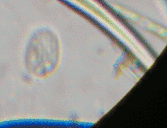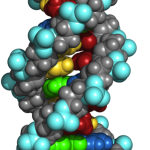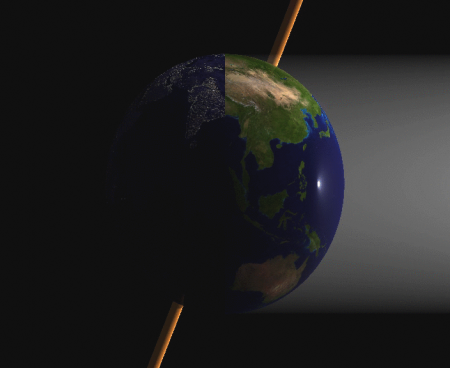What if the other planets in the solar system were orbiting the Earth in place of the Moon? This is what it would look like:
Category: Natural World
What is “Natural”?

Back in 1991, Jay Anderson wrote and interesting article (free pdf) on how exactly to go about measuring “naturalness”.
After all, anywhere you go in this world, you’ll find it has been impacted by humans to some degree: agriculture in Brazil is affecting rainfall patterns in the remotest parts of the Amazon basin; and soot and anthropogenic chemicals gently, and subtly, contaminate the remotest Antarctic Ice Caps.
Anderson came up with three things to look at, but I think the two key are:
- how much things would change if you removed people,
- how many native species there are compared to how many their were in the past.
I think it’s important to try to at least better define what we mean by the word “natural” as we think about conserving the environment.

Anderson’s first point, about how much things would change if you removed the people, also brings to mind Alan Weisman’s book, The World without Us, which imagines what the world would look like if humans disappeared: what would happen to the cities and artifacts we leave behind?

Cellular invasion
Watch the malaria parasite invade a human red blood cell. It takes 30 seconds.
(via New Scientist blog)
Amoebas “farming” bacteria


Well, since certain organelles within our cells (mitochondria) have their own DNA, it’s been suggested that they were once separate organisms that became the ultimate symbionts. Now, someone’s found that single celled amoebas may actually farm the bacteria they eat.
P.S. While looking for a picture of the guilty party, I came across this nice image of the amoeba, Dictyostelium discoideum, splitting into two on Wikimedia Commons.
Recessive genetic diseases can be useful!

Misha Angrist, who is having his entire genome published online, argues that extricating genetic diseases from the population can have unintended consequences:
“… the genome is a dynamic thing, and a balancing act. Sickle cell trait has persisted because carrying it protects one from getting malaria. Who’s to say that carrying one copy of a cystic fibrosis mutation doesn’t similarly protect us against cholera or various diarrheal illnesses? If we eliminate those mutations from the population, are we opening the door to a future of intestinal problems?
–Misha Angrist in an interview with Maud Newton, A Conversation with Misha Angrist, Publisher of His Genome
(via: The Daily Dish)
POV-Ray: 3d rendering
Giles Tran’s amazing rendering of glasses on the counter inspired me to check through my own POV-Ray generated library. Nothing nearly as good, but some of it is still might be useful.


You build 3d models in POV-Ray and then export 2d images from whichever point of view you want, so once you have the model set up you can easily change the perspective or even move objects to create animations.
POV-Ray does not have any useful sort of user interface; you’re usually creating your models with computer code. It can therefore be challenging to use, and, as with any 3d programming language, a bit of geometry, trigonometry and algebra are needed.
However, the final results can be impressive. I’m continually amazed each year by the quality of the work added to their Hall of Fame.
For much easier, quicker and not so sophisticated 3d results, I use VPython, which is also a great way to learn programming that outputs 3d images.
Genetic testing: What it can do, and where we are.
“On average we found that each of us carries two or three mutations that could cause one of these severe childhood diseases.”
–Stephen Kingsmore, physician, Children’s Mercy Hospital in Greenfieldboyce (2010), New Genetic Test Screens Would-Be Parents.
NPR’s All Things Considered had two related articles on last night that deal with the specific topics we’re covering this week: genetic disease and recessive alleles.
The first one is about the latest in genetic screening technology, for determining if potential parents have recessive alleles that could combine to produce children with genetic diseases. Recent research has made this much easier.
The second touches on the ethical consequences of genetic screening. It could lead to an increase in abortion rates and leads us along the slippery slope of eugenics.

This second story would make an interesting basis for a Socratic dialogue. As would, I think, the movie Gattica, which deals with the consequences of genetic screening and genetic customizations. I see it’s PG-13 so we may be able to screen it. Similarly, I may recommend Brian Stableford’s War Games to my eight graders who might like a military science fiction book that deals with genetic optimization. Alternatively, Nancy Kress’ Beggars in Spain might offer another interesting perspective on this issue.
DNA –> proteins
Learn.Genetics have some very nice animations and exercises that deal with DNA, genes and protein synthesis. At the moment, I’m finding the following particularly useful:
- Instruction on how to extract DNA from anything, (I’m going to use this as a lab and perhaps to make pea soup too) and specifically, from people (inside of your cheek).
- What makes a firefly glow animation. It’s a bit dense, but complements the transcribe and translate a gene exercise nicely.
- The Observable Traits Slideshow identifies some of the same traits we look for in our exercises: dimples, handedness, etc. (they have a quick reference pdf.
- There are a bunch of great traits activities, including family tree building, and traits bingo.
